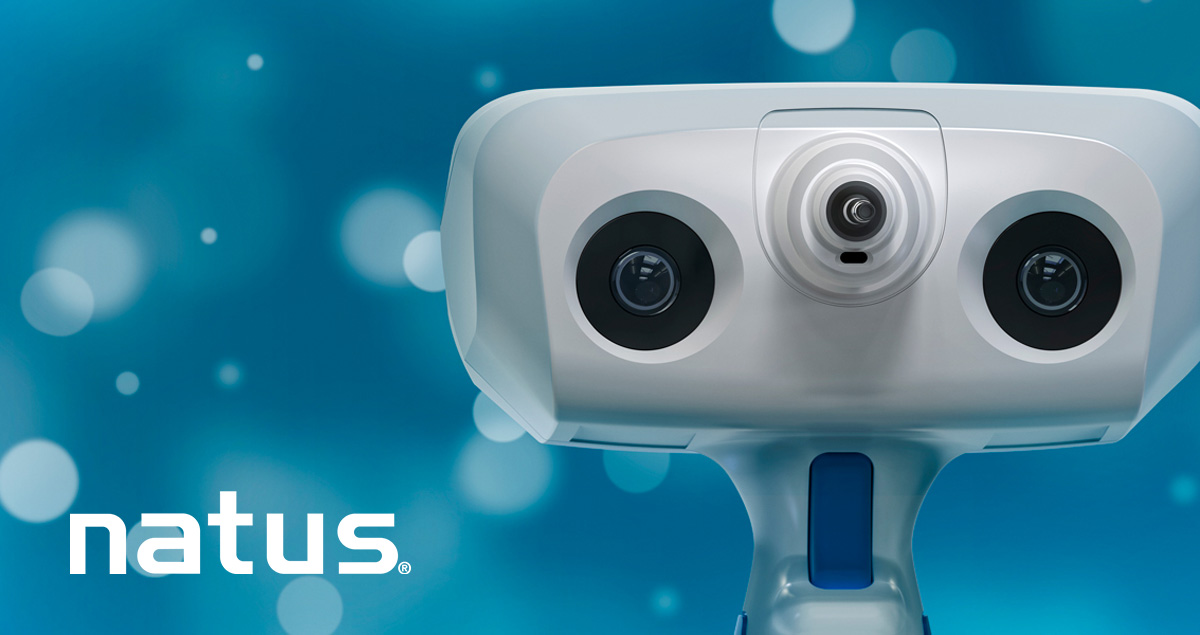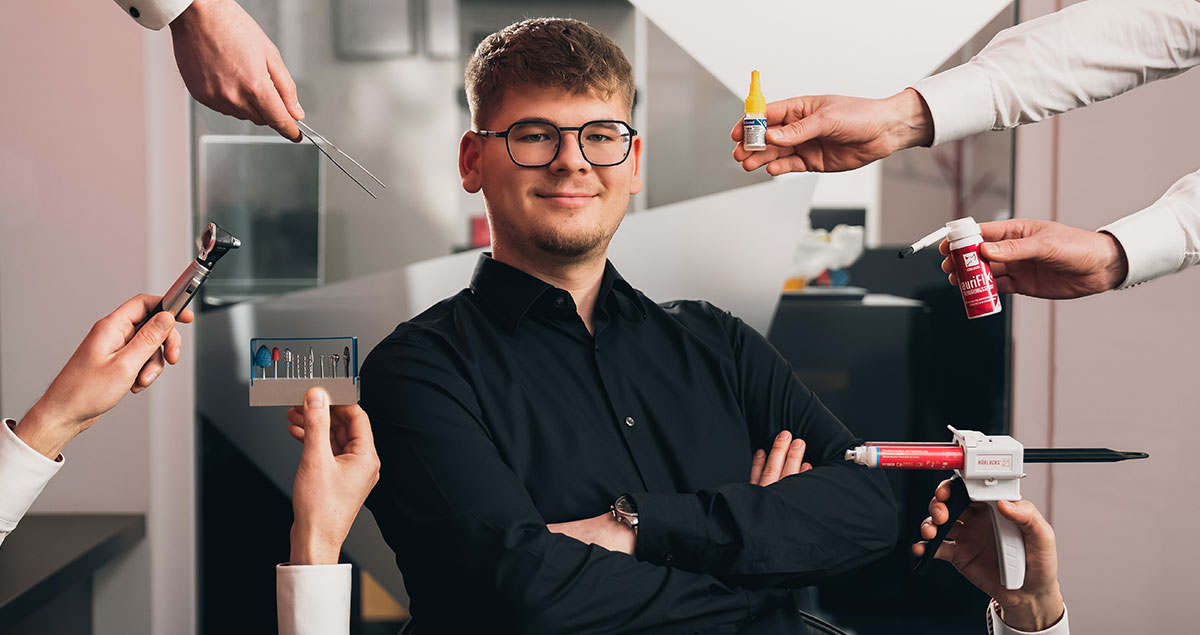Hörluchs® is one of the world’s leading Otoscan users as a recipient of 3D scans and thus also a leading supplier of earmolds manufactured from Otoscan data.
In an interview with Christoph Schulte of Natus, Martin Baumann (Head of the Audiology Department) and Dominic Schmidt (former Deputy Managing Director) discussed this topic:
Being a laboratory, what makes Hörluchs® special, what innovations or milestones have there been?
Hörluchs® was founded almost 10 years ago and is one of the leading experts in Germany when it comes to custom-made earmolds, hearing protection and professional in-ears. We celebrated our first breakthrough back then with the first approved ICP hearing system for the workplace, for which acousticians had to get certified and thus came into contact with us. Over the years, the product portfolio has steadily expanded. In the beginning, we milled earmolds for our own stores, then we added more hearing protection products and in-ears. 3 years ago we introduced THERMOtec® and last year the titanium earmolds with our own 3D production. Over the years, we have grown step by step along with the hearing care market and now offer a very comprehensive portfolio plus professional know-how that an acoustician needs in everyday life. We don’t want to define ourselves only by the laboratory, but by our Hörluchs® Campus, where we pass on practical input to the acousticians.
You have extremely exciting products in your portfolio, such as the first competitive titanium earmold? How has this been received by the market in the meantime? What are the advantages?
It is noticeable that acousticians are still somewhat reticent about titanium as a material in some areas. In the past, titanium was used more for medical earmolds before gold had to be used, for example. We tend to look at this material from a different angle. We gathered our first ideas at a dental trade fair and then looked for the right way for us. It was always clear to us that we would like to work completely digitally, without a detour via manual production.
Economically, we then found an innovative solution that is also interesting for the acoustician in terms of price/performance. We can now realize wall thicknesses of up to 0.4 mm in earmold production.
The process was something we had to get very familiar with, especially in the beginning. Not only did we have to look at how to model the parts or how to get it from the modeling to the printer, but we also had to make sure that the finishing processes worked properly. It’s not just a simple “printing process” – with titanium in particular, there’s a bit more to it. For the acoustician, the titanium earmold has several advantages. It is hypoallergenic, very light, unbreakable and has a long service life. Meanwhile, we are also competitive with the product, which makes us very happy. We have customers who tell us about their experience with the titanium earmold, and they are enthusiastic about the material because it is odorless, does not yellow, and is “unbreakable.” Our goal is to make titanium earmold presentable this year.
The hearing care industry is once again undergoing rapid change. Natus and Hörluchs® are in the same boat when it comes to remote fitting and Internet commerce. What do you think?
You have to look at the markets differently here. In recent years, we have seen that the trend, at least in Germany and some other markets, is away from the dome and back towards individual earmolds. It is possible that the Internet trade will become more popular again, e.g. for mild hearing loss. This could be treated with standard domes. But at the latest when the hearing loss has reached a certain degree, earmolds will play a role again. There will always be the customers who buy standard hearing systems.
Online trade also has positive sides for us here. As an acoustician, you want/need to stand out – regardless of whether it’s a large or small chain store. A high-quality fitting is a unique selling point, and that simply includes an individual earmold. This will also remain the case in the future.
Very good! That takes me directly to our actual topic. Where and how did you get to know Otoscan?
We first saw and got to know Otoscan a few years ago at the EUHA fair. After this, we have repeatedly come into contact with the device through various customers, until we then tested it ourselves. The first impressions were very promising, so we even purchased an Otoscan ourselves.
You are one of the world’s leading Otoscan users as a recipient of Otoscan 3D scans and therefore also a leading supplier of earmolds made from Otoscan data. How do you achieve this?
We conduct a lot of training courses in our company, which also deal with impression quality. When we talk about this topic, we also talk about Otoscan. Otoscan produces beautiful, deep and pressureless scans. Defects are immediately visible. Customers also often come up to us during the break to ask us about their experience with the scanner. We pass these on and are also happy to promote the product.
Do you notice any differences in customers using Otoscan versus the average of all other customers?
Our customer base has not changed. What you notice is that if the scan has been done well with the Otoscan, the quality is extremely high and the error rate is very low due to the modeling. Again, a lot depends on the accuracy of the scanning. For example, if there are noted artifacts in the scans, we have exactly the same challenges as with bad impressions. So a lot still depends on the acoustician behind the scanner or the injector. Basically, though, if the scan is done well, it’s easier to create a deep “impression” than with a conventional impression.
Is there an advantage that comes to your mind first? One of the main differences that has generated a lot of interest among our customers right from the start is the 100% “pressureless” scanning of the auditory canal.
The fact that Otoscan is always pressureless makes it easier to prepare. We usually do not know which impression material has been used or whether a scan has been formed with an injector, for example. With Otoscan, the unknown variable is omitted, since Otoscan always works 100% pressureless! The “wax-up dimension” in the design software is also much clearer to determine. We work with Otoscan files with a separate Otoscan Offset in Cyfex to facilitate modeling.
Are there limits to the use of the scanner, e.g. certain ears or customer types, so that a classic impression is more suitable here?
We have often discussed and evaluated such experiences with product management. Especially in the case of very soft ear tissue in conjunction with high-power restorations, it is worth considering whether to revert to conventional impression taking. It is important to look at the ear tissue before taking any impression. Soft ear tissue means a lot of expansion. So whenever pressure on the ear tissue is a desired result especially in sealing zones, impression taking may be more appropriate.
Otoscan is super applicable for hearing instruments that require a comfortable fit and a deep impression, such as CIC or IIC systems. With the Otoscan it is much easier to create a deep scan after the second bend.
With RIC earmolds, it is just as advantageous to have a deeper impression because I can see how the sound outlet or sleeve for the ex-earpiece should be placed. We don’t have that if the impression is cut right at the second bend. An ex-earpiece can be placed very accurately and deeply this way.
Do you have any general tips on the subject of impressions or scans for everyday use that can be implemented directly and from which you can benefit directly as an acoustician?
The most important thing is and remains high quality when creating the scan or the impression on the customer’s ear as the basis for the further production process. In concrete terms, this means: as complete and error-free as possible, a good length of the auditory canal, and a functional impression that is as “pressure-free” as possible. In the case of special features, it helps us as a laboratory enormously if these are indicated at the same time. It is just as important for us to provide advice that is tailored to your needs, e.g. in terms of support and anatomy. Not every product is suitable for every ear or, in the “worst case”, anatomically possible at all. Here, we are of course happy about anyone who dares to try out new technologies such as Otoscan or titanium earmolds in order to make even more possible for their customers and to push back boundaries.





